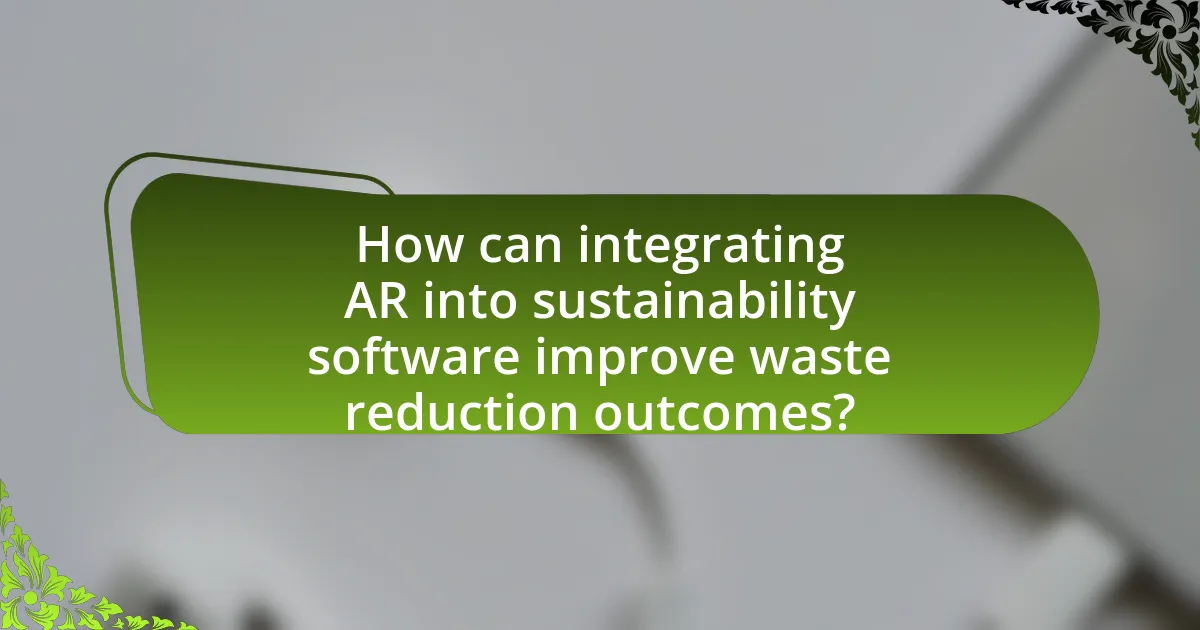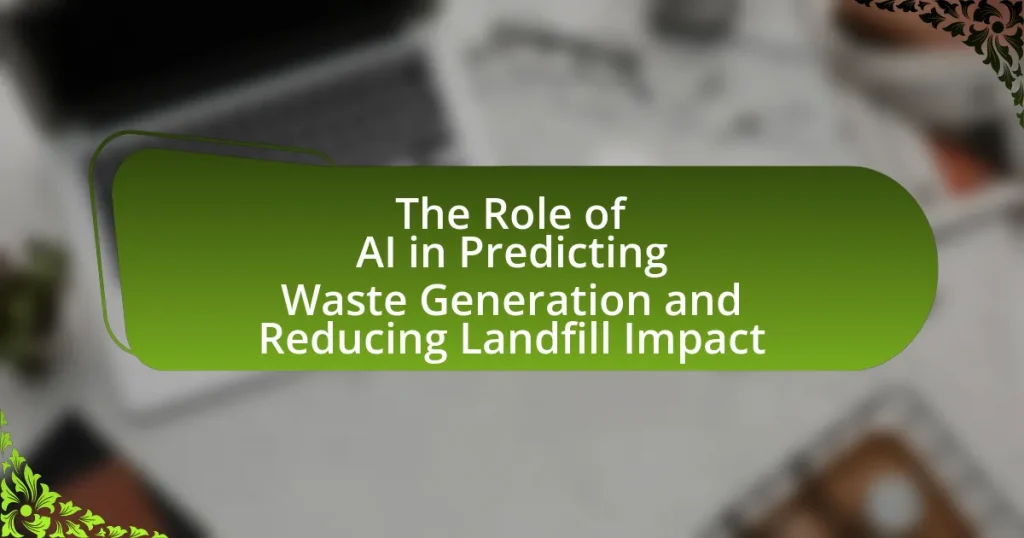The article focuses on the future of waste reduction through the integration of augmented reality (AR) in sustainability software. It highlights how AR can enhance waste management practices by providing real-time data visualization, improving recycling rates, and optimizing resource use. Key drivers of this shift include increasing environmental awareness, regulatory pressures, and economic incentives. The article also discusses the role of data analytics and technological advancements in refining waste reduction strategies, while addressing challenges such as user adoption and technical barriers. Overall, it emphasizes the potential of AR to foster a circular economy and promote sustainable practices in waste management.

What is the Future of Waste Reduction?
The future of waste reduction involves the integration of advanced technologies, particularly augmented reality (AR), into sustainability software. This integration is expected to enhance waste management practices by providing real-time data visualization, enabling users to identify waste sources and optimize resource use effectively. For instance, a study by the Ellen MacArthur Foundation highlights that digital technologies, including AR, can significantly improve recycling rates and reduce contamination in waste streams. As organizations adopt these technologies, they can achieve more efficient waste reduction strategies, ultimately contributing to a circular economy.
How is waste reduction evolving in modern society?
Waste reduction is evolving in modern society through the integration of advanced technologies, particularly augmented reality (AR), into sustainability software. This evolution is characterized by the development of applications that enable consumers and businesses to visualize waste generation and management in real-time, leading to more informed decision-making. For instance, AR tools can overlay data on waste production patterns, helping users identify areas for improvement and optimize resource use. According to a report by the World Economic Forum, the adoption of such technologies can potentially reduce global waste by up to 30% by 2030, demonstrating the significant impact of innovative solutions on waste reduction efforts.
What are the key drivers behind the shift towards waste reduction?
The key drivers behind the shift towards waste reduction include increasing environmental awareness, regulatory pressures, and economic incentives. Environmental awareness has grown significantly, with studies indicating that 72% of consumers prefer brands that demonstrate sustainability efforts. Regulatory pressures, such as the European Union’s Circular Economy Action Plan, mandate waste reduction practices, pushing businesses to adapt. Economic incentives, including cost savings from reduced material use and waste disposal fees, further motivate organizations to implement waste reduction strategies. These factors collectively drive the transition towards more sustainable waste management practices.
How do technological advancements influence waste reduction strategies?
Technological advancements significantly enhance waste reduction strategies by enabling more efficient resource management and optimizing recycling processes. For instance, innovations such as artificial intelligence and machine learning facilitate better sorting of recyclable materials, leading to increased recovery rates. According to a study by the Ellen MacArthur Foundation, implementing advanced sorting technologies can improve recycling efficiency by up to 30%, thereby reducing landfill waste. Additionally, augmented reality applications in sustainability software allow users to visualize waste generation and management in real-time, promoting informed decision-making and behavioral changes that further minimize waste.
Why is integrating technology crucial for waste reduction?
Integrating technology is crucial for waste reduction because it enhances efficiency in resource management and promotes informed decision-making. For instance, technologies like augmented reality (AR) can visualize waste streams, allowing organizations to identify inefficiencies and optimize processes. A study by the Ellen MacArthur Foundation highlights that digital technologies can reduce waste by up to 30% in various sectors by improving tracking and management of materials. This integration not only minimizes waste generation but also fosters a circular economy, where resources are reused and recycled effectively.
What role does software play in enhancing waste management practices?
Software plays a crucial role in enhancing waste management practices by optimizing resource allocation, tracking waste generation, and facilitating data analysis. For instance, software solutions enable real-time monitoring of waste collection routes, which can reduce operational costs by up to 30% and improve efficiency. Additionally, data analytics tools help municipalities and organizations identify waste patterns, leading to more effective recycling programs and waste reduction strategies. According to a study by the Environmental Protection Agency, implementing software-driven waste management systems can increase recycling rates by 20% or more, demonstrating the significant impact of technology in promoting sustainable waste practices.
How can data analytics improve waste reduction efforts?
Data analytics can significantly improve waste reduction efforts by enabling organizations to identify patterns and inefficiencies in waste generation. By analyzing data from various sources, such as production processes, supply chain logistics, and consumer behavior, organizations can pinpoint areas where waste is most prevalent. For instance, a study by the Environmental Protection Agency found that businesses using data analytics to track waste streams reduced their waste by up to 30% within a year. This reduction is achieved through targeted interventions, such as optimizing resource use, improving inventory management, and enhancing recycling programs based on data-driven insights.
-and-its-relevance-to-sustainability-2.webp)
What is Augmented Reality (AR) and its relevance to sustainability?
Augmented Reality (AR) is a technology that overlays digital information onto the real world, enhancing the user’s perception of their environment. Its relevance to sustainability lies in its ability to facilitate waste reduction and promote efficient resource management. For instance, AR can assist in visualizing waste sorting processes, enabling users to identify recyclable materials more effectively, which can lead to increased recycling rates. A study by the University of Cambridge found that AR applications in waste management can improve user engagement and understanding, ultimately contributing to more sustainable practices.
How does augmented reality function in the context of sustainability software?
Augmented reality (AR) enhances sustainability software by providing interactive visualizations that help users understand and manage environmental impacts. AR overlays digital information onto the physical world, allowing users to visualize data related to waste management, resource consumption, and energy efficiency in real-time. For instance, AR can display the carbon footprint of products in a retail environment, enabling consumers to make informed choices. This functionality is supported by studies showing that AR can improve user engagement and retention of information, leading to more sustainable behaviors.
What are the main features of AR that support waste reduction initiatives?
Augmented Reality (AR) supports waste reduction initiatives primarily through enhanced visualization, real-time data integration, and interactive user engagement. Enhanced visualization allows users to see the environmental impact of their choices, such as waste generation and recycling options, which can lead to more informed decision-making. Real-time data integration provides users with up-to-date information on waste management practices, enabling them to optimize resource use and minimize waste. Interactive user engagement through AR applications encourages participation in sustainability efforts, making users more aware of their consumption patterns and promoting waste reduction behaviors. These features collectively contribute to more effective waste management strategies and foster a culture of sustainability.
How can AR enhance user engagement in sustainability practices?
Augmented Reality (AR) can enhance user engagement in sustainability practices by providing immersive, interactive experiences that educate users about environmental impacts and encourage sustainable behaviors. For instance, AR applications can visualize the effects of waste on ecosystems, allowing users to see the consequences of their actions in real-time, which can lead to increased awareness and motivation to adopt sustainable practices. Research indicates that immersive technologies like AR can improve knowledge retention by up to 75%, making users more likely to engage with sustainability initiatives actively.
What are the potential applications of AR in waste reduction?
Augmented Reality (AR) can significantly contribute to waste reduction through applications such as enhanced recycling education, real-time inventory management, and improved product design. By using AR, individuals can visualize proper recycling methods, which has been shown to increase recycling rates by up to 30% in some studies. Additionally, AR can assist businesses in managing inventory more efficiently, reducing overproduction and waste by providing real-time data on stock levels and product demand. Furthermore, AR can facilitate the design process by allowing designers to simulate products in a virtual environment, leading to more sustainable choices and minimizing material waste during production.
How can AR be used for educational purposes in waste management?
Augmented Reality (AR) can be used for educational purposes in waste management by providing interactive and immersive experiences that enhance learning about waste reduction and recycling practices. AR applications can visualize waste sorting processes, allowing users to see how different materials should be disposed of or recycled in real-time. For instance, a study by the University of Southern California found that AR can improve knowledge retention by 70% compared to traditional learning methods, demonstrating its effectiveness in conveying complex information about waste management. Additionally, AR can simulate real-world scenarios, enabling users to engage in virtual waste management challenges, thereby fostering critical thinking and problem-solving skills related to sustainability.
What innovative solutions can AR provide for real-time waste tracking?
Augmented Reality (AR) can provide innovative solutions for real-time waste tracking by enabling visual overlays that enhance data interpretation and decision-making. AR applications can display real-time waste levels, identify types of waste, and track disposal routes through interactive visualizations, allowing users to monitor waste management processes effectively. For instance, AR can utilize GPS data to show the location of waste bins and their fill levels, facilitating timely collection and reducing overflow incidents. Studies have shown that integrating AR with IoT sensors can improve operational efficiency by up to 30%, as it allows for immediate adjustments based on real-time data. This integration not only streamlines waste management but also promotes sustainable practices by providing actionable insights into waste generation patterns.

How can integrating AR into sustainability software improve waste reduction outcomes?
Integrating augmented reality (AR) into sustainability software can significantly improve waste reduction outcomes by enhancing user engagement and providing real-time data visualization. AR allows users to visualize waste management processes and recycling options in an interactive manner, which can lead to better decision-making and increased awareness of waste reduction practices. For instance, a study by the University of Cambridge found that AR applications in waste management can increase recycling rates by up to 30% by providing users with immediate feedback on their waste disposal choices. This immediate feedback loop encourages users to adopt more sustainable behaviors, ultimately leading to a decrease in overall waste generation.
What benefits does AR integration offer to sustainability software users?
AR integration offers sustainability software users enhanced visualization and real-time data interaction, which significantly improves decision-making processes. By utilizing AR, users can visualize complex data sets and environmental impacts in an interactive manner, leading to better understanding and engagement with sustainability initiatives. For instance, a study by the University of Cambridge found that AR applications can increase user retention of information by up to 70%, thereby fostering more effective waste reduction strategies. Additionally, AR can facilitate remote collaboration, allowing teams to work together on sustainability projects regardless of location, which can streamline processes and reduce resource consumption.
How does AR facilitate better decision-making in waste management?
Augmented Reality (AR) facilitates better decision-making in waste management by providing real-time data visualization and interactive simulations. This technology allows waste management professionals to visualize waste streams, identify inefficiencies, and optimize collection routes. For instance, AR can overlay digital information on physical environments, enabling users to see the impact of different waste management strategies before implementation. Studies have shown that AR applications can improve operational efficiency by up to 30%, as they enhance situational awareness and enable data-driven decisions.
What are the cost implications of implementing AR in sustainability software?
Implementing augmented reality (AR) in sustainability software incurs significant initial costs, primarily due to the need for advanced technology, software development, and training. The integration of AR requires investment in hardware such as AR glasses or mobile devices, which can range from hundreds to thousands of dollars per unit. Additionally, custom software development to create AR applications can cost between $50,000 to $200,000, depending on complexity and features. Training staff to effectively use AR tools adds further expenses, potentially increasing overall implementation costs by 20% to 30%. These costs are justified by the potential for enhanced data visualization, improved decision-making, and increased operational efficiency, which can lead to long-term savings and sustainability benefits.
What challenges might arise when integrating AR into waste reduction software?
Integrating augmented reality (AR) into waste reduction software may face several challenges, including technical limitations, user adoption issues, and data integration complexities. Technical limitations arise from the need for advanced hardware and software capabilities, which may not be universally available, potentially hindering effective implementation. User adoption issues can stem from a lack of familiarity with AR technology among users, leading to resistance or ineffective use of the software. Additionally, data integration complexities occur when aligning AR functionalities with existing waste management systems, requiring significant resources and expertise to ensure seamless operation. These challenges highlight the need for careful planning and investment in training and infrastructure to successfully integrate AR into waste reduction initiatives.
How can organizations overcome technical barriers to AR implementation?
Organizations can overcome technical barriers to AR implementation by investing in robust infrastructure and ensuring compatibility with existing systems. This involves upgrading hardware to support AR applications, such as high-performance processors and advanced graphics capabilities, which are essential for rendering AR content effectively. Additionally, organizations should prioritize software integration, ensuring that AR tools can seamlessly interact with current sustainability software systems. Research indicates that companies that adopt a phased implementation strategy, starting with pilot projects, can identify and address technical challenges early, leading to more successful full-scale deployments. For instance, a study by PwC found that 67% of organizations that implemented AR reported improved operational efficiency, highlighting the importance of addressing technical barriers for successful integration.
What are the user adoption challenges associated with AR technology?
User adoption challenges associated with AR technology include high costs, lack of user-friendly interfaces, and insufficient training resources. High costs deter organizations from investing in AR solutions, as initial setup and ongoing maintenance can be significant. Additionally, many AR applications have complex interfaces that can overwhelm users, leading to frustration and decreased engagement. Furthermore, the absence of comprehensive training programs limits users’ ability to effectively utilize AR technology, resulting in underutilization of its potential benefits. These challenges collectively hinder the widespread adoption of AR in various sectors, including sustainability software.
What best practices should organizations follow when implementing AR for waste reduction?
Organizations should prioritize user training and engagement when implementing augmented reality (AR) for waste reduction. Effective training ensures that employees understand how to utilize AR tools to identify waste sources and optimize processes. Additionally, organizations should integrate AR with existing waste management systems to enhance data accuracy and real-time monitoring. Research indicates that companies using AR in waste management can achieve up to a 30% reduction in waste through improved operational efficiency. Furthermore, organizations should continuously gather feedback from users to refine AR applications, ensuring they meet the evolving needs of waste reduction initiatives.
How can organizations ensure effective training for users of AR technology?
Organizations can ensure effective training for users of AR technology by implementing a structured training program that includes hands-on experience, clear instructional materials, and ongoing support. Research indicates that experiential learning significantly enhances user engagement and retention, making practical exercises essential for mastering AR applications. Additionally, providing comprehensive documentation and tutorials tailored to specific AR tools can facilitate understanding and usability. Continuous feedback mechanisms, such as surveys and performance assessments, can help organizations refine their training approaches, ensuring they meet user needs effectively.
What strategies can enhance the long-term sustainability of AR solutions?
To enhance the long-term sustainability of augmented reality (AR) solutions, integrating user feedback mechanisms is essential. Continuous user engagement allows developers to refine AR applications based on real-world usage, ensuring they meet evolving needs and remain relevant. Additionally, adopting open standards and interoperability can facilitate integration with other technologies, promoting wider adoption and reducing redundancy. Research indicates that AR solutions that prioritize energy efficiency and resource optimization contribute significantly to sustainability goals, as evidenced by a study from the International Journal of Environmental Science and Technology, which highlights that energy-efficient AR applications can reduce operational costs by up to 30%. Furthermore, establishing partnerships with sustainability-focused organizations can drive innovation and provide access to best practices, enhancing the overall impact of AR solutions on waste reduction and environmental sustainability.



